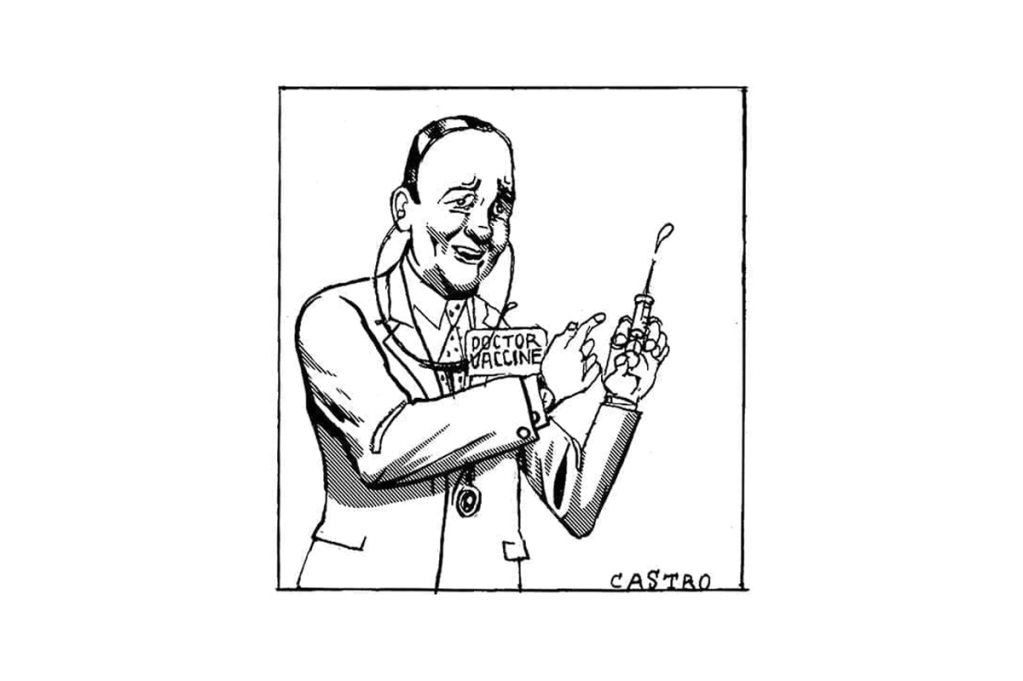It’s probably now the longest running conflict since the Hundred Years’ War: Richard Nixon declared the “war on cancer” fifty-one years ago. The enemy is still in the field, killing more people than ever as other causes of mortality shrink. But cancer is at last giving ground.
Fresh from its triumph in the race to make a vaccine for Covid-19, the German biotech company BioNTech has announced promising results using a similar vaccine against pancreatic cancer. Of sixteen people given the vaccine shortly after they had their tumor surgically removed, eight were cancer-free eighteen months later. That may not sound like much and these are small numbers, but they are being greeted with enthusiasm. Pancreatic cancer is usually lethal within a year because it shows few symptoms till it has spread to the rest of the body, and this was just a phase-1 trial, intended to test the safety rather than the efficacy of the treatment.
Before the pandemic, BioNTech had always planned to use its messenger RNA vaccines against cancer, rather than infection. The idea behind the treatment makes sense. You find some fragments of protein unique to the individual patient’s tumor and send in the genetic codes for them in a form that will alert the body’s immune system. It’s like reading the enemy’s codes and supplying the security services with information about enemy agents operating inside your country.
Surviving cancer is a war of attrition against an adaptive enemy. Tumors evolve. Their cells, bent on replicating at all costs, make mistakes and mutate in random ways. The mutants compete to dominate the tumor, which rapidly selects for any variants that resist the body’s defenses or the drugs thrown at them. It’s natural selection on steroids. Imagine Russian tanks that breed new ones, some of which become immune to NLAW missiles: they would soon come to dominate the battlefield. Seeing cancer as a form of evolutionary arms race helps explain why the war has taken so long.
But the statistics are more and more encouraging. The five-year, age-standardized net survival rate for all cancers in England and Wales doubled from 25 percent to 49 percent between 1971 and 2011, according to Cancer Research UK. That this improvement is down to better treatment as well as earlier diagnosis is proved by the one-year survival rate having improved about half as fast as the five-year rate.
Moreover, that data ends just as the really promising treatments, based on immunotherapy, kicked in. Drugs called immune checkpoint inhibitors, which stop the cancer cunningly disabling the immune system’s reaction, have been huge life-savers since 2000. Newer versions of immunotherapy join toxins to antibodies, so they can be carried right to the heart of tumors, effectively delivering explosives into the enemy’s HQ.
Since 2017, a new idea called personalised CAR-T cell treatment has shown even better results against blood cancers, though not against solid tumors. This takes the form of “living drugs”: T cells taken from the body’s immune system and selected for their ability to target the specific cancer in your body and nothing else. A bit like training special forces to infiltrate a specific compound in Abbottabad where a bad guy lives.
BioNTech’s treatments look capable of tackling solid tumors too. They are effectively genetic versions of the same idea as CAR-T cells: they send in not cells but genetic instructions. Somewhere here there’s an analogy from the plot of the latest Bond movie — weapons that kill only highly specific individuals — but maybe it’s time to disarm the military metaphor before it blows up.
For all today’s optimism, hopes of curing cancer have been dashed before. Twenty years ago there was much excitement about drugs that cut off the blood supply to solid tumors, but cancer cells proved all too quick at evolving ways of disabling the drugs. So it would be wrong to get too hopeful. Then there is the cost. Personalized vaccines built to treat single patients will be prohibitively expensive, at least at first. This is where ingenuity is required. The lipid package in which a vaccine comes, and the raw ingredients of its RNA code, are standardized products. Bespoke arrangements of individual RNA sequences surely need not remain excessively expensive, any more than short runs of fashion garments in textile factories.
One reason the war on cancer can never be finally over is because it is a disease of age. Those of us in Sniper’s Alley generally don’t need reminding that your chances of developing cancer double between fifty-five and sixty-five. So the longer we all live, the more we run the risk of a mutation in some tissue triggering an explosion of greedy, fast-adapting cells stealing our lunch and our lives. The more you survive cancer, the more likely you are to get it again in another part of the body.
The silver lining here is that when you get really old — past ninety — cancer rates drop rapidly. Over 100, cancer affects less than 4 percent of people and kills very few. As one paper puts it: “In general, cancer in the oldest-olds seems to be a more silent disease, of slower growth and less threatening.” Apparently your metabolism is just too slow to fuel a metastatic tumor.
Even if we will never get rid of cancer, at least we can expect milder treatments. The newer immunotherapy drugs are generally a lot less brutal than the cruel tortures inflicted in the past. I may well be wrong here, but I have a feeling we might be able to phase out the blunt instrument known as radiotherapy one day in the not too distant future. We will look back on the idea of blasting the body with gamma rays as primitive. Likewise those terrible chemotherapies that seemed to work by killing people only slightly more slowly than they killed the cancer. Let’s hope so, anyway.
This article was originally published in The Spectator’s UK magazine. Subscribe to the World edition here.

























